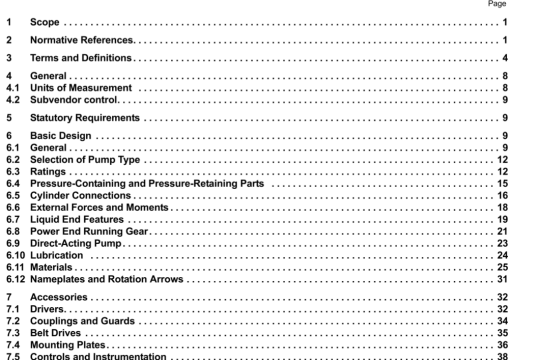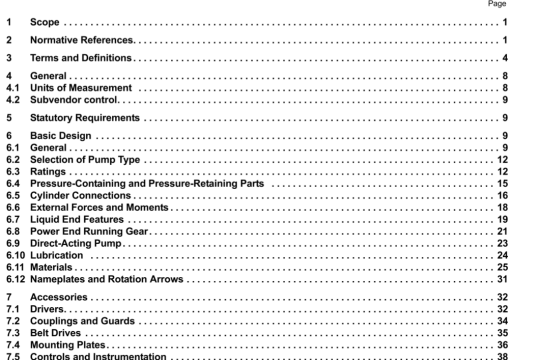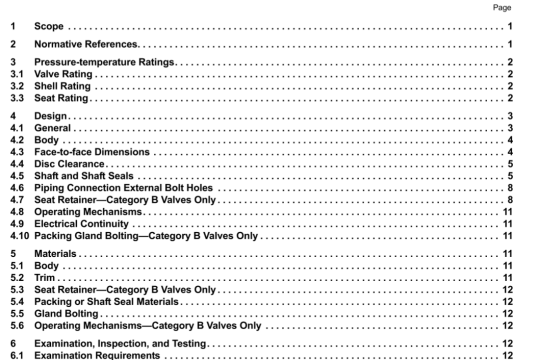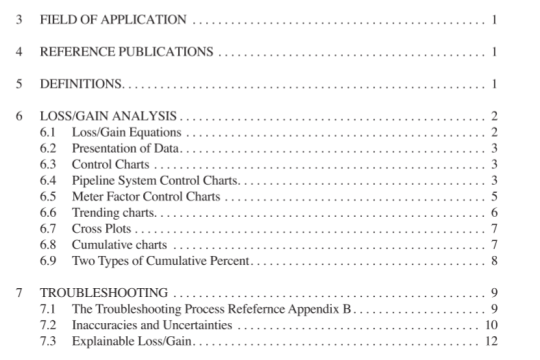API 607:2005 pdf download
API 607:2005 pdf download.Fire Test for Soft-seated Quarter-turn Valves.
5.3.2 Specific apparatus
5.3.2.1 Vapour trap to minimise the cooling effect of the upstream liquid. See Figure 1. (8).
5.3.2.2 IndustrIal pressure measurement devices having a full-scale reading of between 1.5 and 4 times the pressure being measured. The accuracy of each test device used at any point on the scale shall be wIthin 3 % of Its maximum scale value for readings taken both up and down the scale with either increasing or decreasing pressure. See Figure 1, (7), (14).
5.3.2.3 Calorimeter cubes made of carbon steel in accordance with the design and dimensions shown
In Figure 2, with a thermocouple of the accuracy specified In 5.3.2.4. located in the centre of each cube.
Calorimeter cubes shall be scale-free before exposure to the fire environment.
5.3.2.4 Flame environment and valve body thermocouples of an accuracy at least equal to tolerance class 2 for type B or tolerance class 3 for other types as specified in IEC 60584-2. See Figure 1, (13).
5.3.2.5 ContaIners of a size suitable for collecting the water leaked from the valve under test. See Figure 1, (18).
5.3.2.6 Calibrated sight gauge or device for measuring the water used during the test. See Figure 1,
(4).
5.3.2.7 Calibrated device for measuring the leakage water collected dunng the test.
5.3.2.8 Pressure relief provision, incorporated in the system, consisting of a pressure relief valve to relieve the test valve centre cavity pressure to the atmosphere, to protect against potential rupture of the valve if it is designed such that liquid can be trapped in the cavity. See Figure 1, (14).
The pressure relief valve selling shall be
either that determined by the valve manufacturer from data obtained by hydrostatic pressure testing of valves of the same size and type as the fire-tested valve, or
— when pressure test data Is not available, a setting not greater than 1.5 tImes the maximum permissible working pressure at 20 C.
5.4 Test fluid
The test fluid used shall be water.
5.5 Test fuel
The test fuel shall be gaseous,
5.6 Procedure
NOTE The numbered Items In parentheses refer to the apparatus of Figure 1.
5.6.1 Mount the test valve in the test apparatus so that the stern and bore of the valve are in the horizontal position. Mount a valve that operates In only one direction (unidirectional) in their normal operating position.
Locate the flame environment, body thermocouples and calorimeter cubes in the positions shown In Figures 3 and 4, as appropriate.
For soft-seated valves up to DN 100 or NPS 4 and pressure ratings up to PN 40, Class 300. use two flame environment thermocouples, two body thermocouples and calorimeter cubes as shown in Figure 3.
For all other valves, use two flame environment thermocouples and two calorimeter cubes as shown in Figure 4. For valves DN 200 or NPS 8 and larger, use a third calorimeter cubes as shown in Figure 4.
5.6.2 With the test valve in the partially open position, open the water supply valve (5), the shut-off valve (6). the vent valves (16) and the shut-off valve (15) to flood the system and purge the air. When the system is completely filled with water, close the shut-off valve (15), the vent valves (16) and the water supply valve (5). Pressurize the system with water to a test pressure of 1.4 times the maxwnum permissible working pressure at 20 C — the actual test pressure may be rounded up to the next highest bar1 . Check for leaks in the test apparatus and eliminate as necessary. Release the pressure, close the test valve and open the shut. off valve (15).
5.6.3 If the valve under test is of the upstream sealing type, determine the volume of water that is trapped between the upstream seat seal and the downstream seat seal when the valve is closed. Record this volume.
Ills assumed that, during the tire type-test, this volume of water will flow through the valve and pass the downstream seat seal to be collected in the container (18). Since this volume has not actually leaked through the upstream seat seal, it is deducted from the total volume collected In the downstream container when determining the through-seat leakage (see 5.6,11).
5.6.4 Pressurize the system to one or the other of the following pressures, as appropriate:
a) for soft-seated valves rated PN 10, PN 16. PN 25 and PN 40, Class 150 and Class 300, the low test pressure at 0.2 MPa (2 bar);
b) for all other valves, the high test pressure at 75 % of the maximum permissible seat working pressure at
20 C.
Maintain this test pressure during the bum and cool-down periods, momentary pressure losses of up to 50 % of the test pressure being permitted provided that the pressure recovers within 2 mm and the cumulative durabon is less than 2 mm.
5.6.5 Record the reading on the calibrated sight gauge or device (4). Empty the container (18).
5.6.6 Adjust the test system, excluding the test valve, during the test penod to maintain the temperatures
and pressures required.
5.6.7 Open the fuel supply, establish a fire and monitor the flame environment temperature throughout the burn period of 30 mm. Check that the average temperature of the two flame environment thermocouples (13) reaches 750 C within 2 mm from the start of the burn period, Le. from ignition of the burners. Maintain the average temperature between 750 C and 1 000 C, with no reading less than 700 C for the remainder of the burn period of 30 mm.




